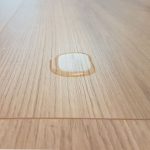Painted metal objects lose their appearance and also their effectiveness once they peel and chip. To restore such metal objects, you need to repaint them, but only after removing the old paint. If you don’t fancy those ready-to-use paint removers available for purchase in hardware stores and would like something that’s more natural or chemical-free, make your own paint remover.
To make a homemade paint remover for metal, you’ll need some baking soda and boiling water. You’ll also need a few other tools, which include a pot, stove, a pair of tongs, safety gloves, an old toothbrush, and some dry dishcloths. Make sure the pot you use is not or will not be used for cooking.
Keep reading for a step-by-step tutorial on how to make a homemade paint remover for metal with baking soda and water. You will also learn why baking soda is the ideal substance, along with some other tools you could use to remove paint.
Table of Contents
Items Needed to Make Your DIY Paint Remover
The things you’ll primarily need for your DIY metal paint remover are baking soda (1/4 cup) and boiling water. As aforementioned, the other items you’ll require are:
- An old (preferably unused) pot
- A stove to heat water
- Dry dishcloths
- A pair of tongs
- Safety gloves
- An old toothbrush
If you don’t have baking soda in the house, the Pure Organic Ingredients’ Sodium Bicarbonate is the right one for the job. The other tools could also be easily bought online or locally.
How to Remove Paint Using Baking Soda
To remove paint from metal surfaces with baking soda, follow these steps:
- Take a large pot that is big enough to hold the metal object.
- Add water to the pot and bring it to a boil. The amount of water added should fully immerse the metal object.
- Add in ¼ cup of baking soda into the boiling water. Do not mix or stir.
- Insert the metal object and let it stay in the pot for 20 minutes.
- Use a pair of tongs to take the metal object out of the pot.
- Place the metal object on a dry dishcloth for a few minutes until the hot metal is warm to the touch.
- Use an old toothbrush and thoroughly scrub the metal surface to peel away the paint.
How Baking Soda Works as a Paint Remover
In any painted metal object, the paint is held tight on the surface of the metal by strong chemical bonds. Baking soda in boiling water reacts with the paint’s components in a way that causes the chemical bonds to loosen.
The heat of the mixture causes both the metal and the paint to expand. But the expansion proceeds at different speeds and this causes the bonding between them to grow weaker. As a result, the paint separates from the metal layer.
When you scrub the metal object with a mildly abrasive material, such as a toothbrush, the loosened paint easily flakes off, leaving behind an even unpainted metal. After removing this layer of old paint, your metal object is ready to receive a fresh paint job.
Baking soda with boiling water is an effective homemade paint remover that works well with different types of paints – whether they are oil-based, enamel, or acrylic.
Advantages of Using Baking Soda to Remove Metal Paint
There are multiple reasons baking soda is the best ingredient to make your own metal paint remover.
- It’s safe to use and doesn’t cause skin allergies or lead to other health concerns.
- Baking soda is available in most homes or can be easily purchased from the local grocery store.
- Removing paint using baking soda is simple. It doesn’t take too long, and the process isn’t messy either.
Precautions to Take When Using Baking Soda Paint Remover
There are certain things you need to be wary of when making and using baking soda as a DIY metal paint remover. But before you get started, wear your safety gloves. Also, have some old dishcloths handy to work with the hot utensil or to soak up any accidental spills.
Use an Old, Non-Cooking Pot
Make sure you use an old pot that you don’t use for your regular cooking. When the metal is boiled with the baking soda-water mixture, the chemicals in the paint will get released into the utensil. The chemicals may not be entirely washed away, even after you thoroughly clean the pot, and could find their way into your food if you use the utensil for cooking thereafter.
Choose the Right Pot Size
Choose a pot that is roomy enough to hold the metal object. If the pot is too small, the boiling mixture might come too close to the top edges of the pot, increasing the possibilities of the mixture spilling or splashing out. If you want to remove paint off multiple metal items, you may add them all at once provided the pot is big enough to accommodate them all at once.
When in the pot, the metal objects shouldn’t come in contact with each other or the inner sides of the pot. If the pot is not large enough and you cannot find a bigger pot, work with the different metal objects individually.
Drop the Metal Object into the Pot with Care
Drop the metal object into the boiling mixture with care. Slide it in slowly from the edge of the pot so that the hot liquid doesn’t splash out. Also, keep a safe distance from the pot when putting in the metal object.
Other Tools to Remove Paint from Metal Surfaces
Besides the baking soda-boiling water method, here are a couple of tools you could use to remove paint from metal surfaces:
Paint Strippers
Also called paint remover, a paint stripper is a tool fitted with chemicals to remove paint mechanically or through heat. There are pores on the scraper’s tip through which the chemical flows onto the object. When you pass a scraper over a painted metal surface, the chemical reacts with the paint to loosen it. Because of the friction between the scraper and the paint, and also courtesy of the chemical reaction, the paint falls off the metal.
Check this video out if you would like to learn how to use a paint stripper to strip paint from metal:
Electric Heat Gun
An electric heat gun or a steamer is another tool used to remove paint from a metal surface. To remove the paint, hold the steamer pointed over the painted surface. As the temperature rises, the metal will react to the steam. This should loosen the bond between the metal and the pain.
After steaming for about half an hour, the paint will curl and strip away from the metal surface. You may then remove the paint with a paint scraper. Any flakes of paint left on the object can be wiped off later.
Conclusion
Repainting metal may be necessary if the metal has become old, worn-out, or has developed unsightly spots where the paint has peeled or chipped away. Though applying paint directly on the existing paint is not impossible, it’s not advisable since that could lead to an uneven finish or a splotchy appearance.
Therefore, it’s worth putting in the extra effort and time to get rid of the existing paint off the metal before applying fresh paint. The simple and cost-efficient way to remove paint from a metal surface is by making and using your own paint remover. Just make sure you have the right tools and proper safety measures in place before you get started.




